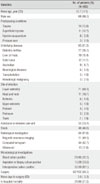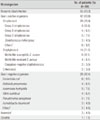Abstract
Background
Necrotizing fasciitis (NF) is an infrequent but potentially lethal infection characterized by rapid progressive destruction of fascia and fat, concomitant systemic toxicity, and high fatality. In spite of the clinical significance of NF, only limited data is available regarding the clinical characteristics of patients with NF in Korea.
Materials and Methods
We retrospectively reviewed the medical records of patients who had been diagnosed as community-acquired NF in 9 centers of the Republic of Korea between January 2000 and November 2010.
Results
During the study period, a total of 103 patients had a community-acquired NF. Of sixty six cases with causative microorganisms identified, the majority (55, 83.3%) had monomicrobial infections. Whereas streptococci were the most common cause of NF in patients without underlying diseases (16/24, 66.7%), variable organisms, such as staphylococci, streptococci, Enterobacteriaceae, and non-fermentative Gram-negative bacilli were causative organisms of NF in patients with underlying diseases. The majority of patients with NF caused by Vibrio vulnificus or Aeromonas hydrophila (7/9, 77.8%) had liver cirrhosis or alcoholism. Surgery to counteract NF was performed in 60.2% of patients with NF (62/102), and mean time to surgery was 3 days. In-hospital mortality was observed in 21 of 99 patients with available data (21.2%). In multivariate analysis, the presence of solid tumors (adjusted OR [aOR]=63.88, 95% CI=2.58-1580.61, P=0.011), shock (aOR= 24.19, 95% CI=2.00-292.19, P=0.012), bacteremia (aOR=87.53, 95% CI=3.99-1921.46, P=0.005), and Gram-negative bacilli infections (aOR=437.11, 95% CI=4.67-40956.82, P=0.009) were associated with in-hospital mortality.
Conclusions
Streptococci were predominant causative organisms of community-acquired NF in patients without underlying diseases. However, in patients with underlying diseases, variable organisms such as staphylococci, streptococci, Enterobacteriaceae, or non-fermentative Gram-negative bacilli were isolated. NF caused by V. vulnificus or A. hydrophila occurred frequently in patients with liver cirrhosis or alcoholism.
Figures and Tables
References
1. Cainzos M, Gonzalez-Rodriguez FJ. Necrotizing soft tissue infections. Curr Opin Crit Care. 2007. 13:433–439.

2. Morgan MS. Diagnosis and management of necrotising fasciitis: a multiparametric approach. J Hosp Infect. 2010. 75:249–257.
3. Anaya DA, Dellinger EP. Necrotizing soft-tissue infection: diagnosis and management. Clin Infect Dis. 2007. 44:705–710.

4. Angoules AG, Kontakis G, Drakoulakis E, Vrentzos G, Granick MS, Giannoudis PV. Necrotising fasciitis of upper and lower limb: a systematic review. Injury. 2007. 38:suppl 5. S19–S26.

5. Wong CH, Wang YS. The diagnosis of necrotizing fasciitis. Curr Opin Infect Dis. 2005. 18:101–106.

6. Sarani B, Strong M, Pascual J, Schwab CW. Necrotizing fasciitis: current concepts and review of the literature. J Am Coll Surg. 2009. 208:279–288.

7. Stevens DL, Bisno AL, Chambers HF, Everett ED, Dellinger P, Goldstein EJC, Gorbach SL, Hirschmann JV, Kaplan EL, Montoya JG, Wade JC. Infectious Diseases Society of America. Practice guidelines for the diagnosis and management of skin and soft-tissue infections. Clin Infect Dis. 2005. 41:1373–1406.

8. Statistics Korea. The Korean Standard Classification of Diseases and Causes of Death. Accessed 23 January 2012. Availiable at: http://kostat.go.kr/kssc/main/MainAction.do?method=sub&catgrp=kssc&catid1=kssc03.
9. Lee MW, Kim TH, Choo EJ, Kang JH, Kim DW, Kim DK, Park SW, An JH, Yoon HG, Eo SJ, Lee GW, Lee YH, Lee JY, Cheon KI. Characteristics of necrotizing fasciitis in three university hospitals in Korea. Korean J Med. 2006. 70:681–687.
10. Park KH, Jung SI, Jung YS, Shin JH, Hwang JH. Marine bacteria as a leading cause of necrotizing fasciitis in coastal areas of South Korea. Am J Trop Med Hyg. 2009. 80:646–650.

11. Vinh DC, Embil JM. Rapidly progressive soft tissue infections. Lancet Infect Dis. 2005. 5:501–513.

12. Choi JP, Lee SO, Kwon HH, Kwak YG, Choi SH, Lim SK, Kim MN, Jeong JY, Choi SH, Woo JH, Kim YS. Clinical significance of spontaneous Aeromonas bacterial peritonitis in cirrhotic patients: a matched case-control study. Clin Infect Dis. 2008. 47:66–72.

13. Stoneback JW, Hak DJ. Diagnosis and management of necrotizing fasciitis. Orthopedics. 2011. 34:196.

14. May AK, Stafford RE, Bulger EM, Heffernan D, Guillamondegui O, Bochicchio G, Eachempati SR. Surgical Infection Society. Treatment of complicated skin and soft tissue infections. Surg Infect (Larchmt). 2009. 10:467–499.

15. Wong CH, Chang HC, Pasupathy S, Khin LW, Tan JL, Low CO. Necrotizing fasciitis: clinical presentation, microbiology, and determinants of mortality. J Bone Joint Surg Am. 2003. 85-A:1454–1460.




 PDF
PDF ePub
ePub Citation
Citation Print
Print





 XML Download
XML Download